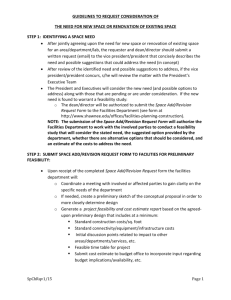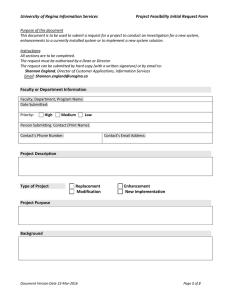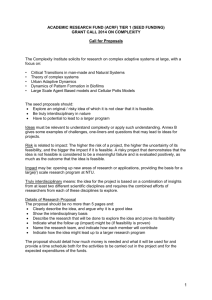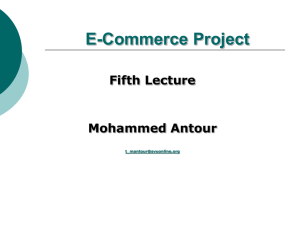09-feasibility
advertisement
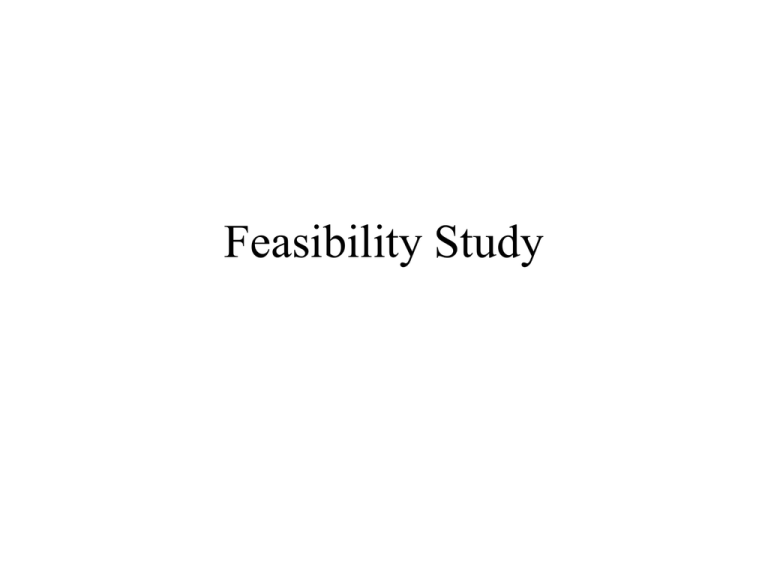
Feasibility Study Requirements Engineering Requirements Definition Feasibility Study Feasibility Report Requirements Elicitation and Analysis Requirements Specification System Models V&V SRS Requirements Definition Document (RDD) *Software Project Management Plan User Manual Test Plan Requirements Engineering Requirements Definition Feasibility Study Feasibility Report Requirements Elicitation and Analysis Requirements Specification System Models V&V SRS Requirements Definition Document (RDD) *Software Project Management Plan User Manual Test Plan Requirements Engineering Requirements Definition Feasibility Study Feasibility Report Requirements Elicitation and Analysis Requirements Specification System Models V&V SRS Requirements Definition Document (RDD) *Software Project Management Plan User Manual Test Plan Feasible • Feasible (‘fee-ze-bel) – capable of being done or carried out; – capable of being used or dealt with successfully; – reasonable, likely. Questions: Can we build a (software) system to meet the client’s expectations? Can we build it under the constraints (cost, time, personnel, …)? Motivation? • Not everything that is imaginable is feasible. • Not everything that is possible is feasible. • Not everything that is technically feasible makes good business sense, i.e., is not feasible in the business environment. Three Main Questions About the Feasibility of a Project • Does it contribute to the overall objective of the organization? • Can it be implemented using current technology within cost and schedule constraints? • Can it be integrated with existing systems (data transfer, procedures)? More Questions: • What are problems with the current system/procedure, and how will the new system address those? • How will the new system contribute to the business objectives? • Does it require “new” technology (technology new to this organization)? • What must be supported in order for the proposed system to function adequately? Feasibility Study Needs to be … • Inexpensive – We are deciding whether to continue the project. – Shouldn’t invest resources with no return. • Quick • Accurate – Conflicts with other items here … Cost Estimation Approaches • Delay estimation until later – Accurate, but not useful • Base estimation on similar project – Assumes you have this experience • Use models to project – Estimates based on size – COCOMO (and others) Feasibility Study • Dimensions of feasibility – Technology – Finance – Time – Resources Dimension of Feasibility Study-1 • Technology – Is the project technically feasible? – Is it within the state of the art? – Can defects be reduced to a level matching the application needs? • Finance – Is the project financially feasible? – Can development be completed at a cost the software organization, the client, or the market can afford? Dimension of Feasibility Study-2 • Time – Will the project’s time-to-market beat the competition? • Resource – Does the organization have the resources needed to succeed? Document Outline A. DOCUMENT CONTROL 1. INTRODUCTION 2. CONSIDERATIONS 3. EXISTING SYSTEMS AND TECHNOLOGIES 4. SOLUTIONS 5. RISKS AND COST ESTIMATES 6. COMPARISON OF SOLUTIONS 7. CONCLUSIONS 8. REFERENCES Contents of Report • Definition of the problem. • Criteria for comparing solutions. • Alternate solutions – Cost estimation – Resources • Input: outline of system description and how it will be used. • Output: brief report recommending if it is worth doing. For this class • Report has a different purpose. • We want to research existing solutions and compare technologies. Document Control Approval The Guidance Team and the customer, Dr. Victor Winter, shall approve this document. Document Change Control Initial Release: Current Release: Indicator of Last Page in Document: Date of Last Review: Date of Next Review: Target Date for Next Update: February 3, 2000 March 2, 2000 March 10, 2000 March 30, 2000 March 28, 2000 Distribution List This following list of people shall receive a copy of this document every time a new version of this document becomes available: Guidance Team Members: Dr. Ann Gates Dr. Steve Roach Francisco Leyva Customer: Dr. Greg Lush Dynamite Software Team Members: Joe Smith Pat Garcia Gabe Rios Natalie Jones Tina Ramos Change Summary The following table details changes made between versions of this document: Version 1.1 1.2 Date 8/15/00 8/30/00 Modifier Natalie Jones Gabe Rios Description Revised definitions Use-case modification Introduction • Introduction – – – – Purpose of the Feasibility Report. Project Description. Justification for the Proposed System. Desired System Functionality. • Use Case Diagram • Actors • Use Case Descriptions – User Interface Description. Considerations • This section establishes the criteria upon which you will evaluate possible solutions. • Identify the primary concerns related to this project. • Decide what aspects of the system are most important. Performance? Security? Usability? • What features in the system matter most? Existing Systems • Describe existing systems that achieve or partially achieve the goals of the proposed system. • The section includes – – – – language discussions. software development tools and libraries. database systems. other tools or software that you might use to build a solution. Solutions • Describe possible solutions. – Each solution should be complete in the sense that it will fully achieve the goals of the proposed system. – If you are using existing software, that software should be described in “Existent Systems” section. • Solution X. – Description (include requirements met). – Resources Needed. • Include software, hardware, experience, training. – Limitations. Risks • Risks and Cost Estimates. – Risks and risk mitigations. – Schedule and cost estimates. Comparison • Discuss how each option measures up against constraints set forth in the statement of requirements and how each compares with the others. • Include: – – – – – – Specific hardware and software requirements Time constraints Ease of use Staffing levels and training required User preference Security issues • A matrix that compares features is required. What you have to provide • Possible solution – May be combination of technologies • Estimation of cost – Hardware & software – level of effort • Estimation of risks – ability to build – stability of technology – … • Recommendations – Give me your professional opinion based on the criteria What you have to consider • Customer needs – – – – – Reliability Robustness Maintainability Delivery time ??? Level of Detail • Assume that the reader is a competent graduate of a CS program. – Don’t tell us about Java, C++, or SQL. – Tell us about technology for the system. • Provide information, not advertising. – What does a technology do for us? – The solution you recommend may be the one you implement. Grand Challenge Question • Can you trace requirements to the Feasibility Report ?





